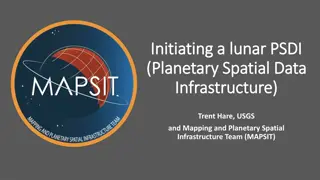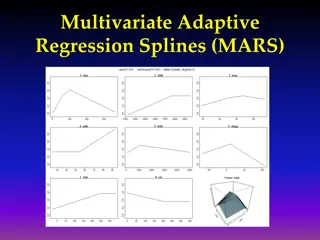Progress Report on Lunar-Mars Spectrum Group Work within SFCG
The Lunar-Mars Spectrum Group (LMSG) met to review important input documents related to lunar communications, including compatibility studies, frequency considerations, and frequency assignment guidelines. The group identified the need for further work to refine proposed reports and agreed on new action items. Detailed discussions took place on integrating new frequency bands for improved communications in the lunar region, with a focus on mobile satellite services. Additional compatibility analysis was deemed necessary for defining frequency usage guidelines in the lunar region.
Download Presentation

Please find below an Image/Link to download the presentation.
The content on the website is provided AS IS for your information and personal use only. It may not be sold, licensed, or shared on other websites without obtaining consent from the author.If you encounter any issues during the download, it is possible that the publisher has removed the file from their server.
You are allowed to download the files provided on this website for personal or commercial use, subject to the condition that they are used lawfully. All files are the property of their respective owners.
The content on the website is provided AS IS for your information and personal use only. It may not be sold, licensed, or shared on other websites without obtaining consent from the author.
E N D
Presentation Transcript
Report to CCSDS/PlaCom on SFCG/LMSG work progress Reply to SLS-PCOM AI-05 of Spring 11 Meeting Jean-Luc Gerner JLG Consulting/CNES Member of SFCG 1
Report to CCSDS/PlaCom on SFCG/LMSG work progress Within the SFCG, the Lunar-Mars Spectrum Group (LMSG) has the following TORs (RES A-26-1): 2
Report to CCSDS/PlaCom on SFCG/LMSG work progress The LMSG met on 8th June 2011, at the yearly meeting of the SFCG. The work concentrated on the review of three input documents: 31-18/D (NASA) DRAFT NEW REPORT: COMPATIBILITY STUDIES FOR COMMUNICATIONS IN THE LUNAR REGION 31-43/D (CNES) FREQUENCIES CONSIDERATION FOR COMMUNICATIONS IN THE LUNAR REGION 31-19/D (NASA) FREQUENCY ASSIGNMENT GUIDELINES FOR COMMUNICATIONS IN THE LUNAR REGION 3
Report to CCSDS/PlaCom on SFCG/LMSG work progress 31-18/D (NASA) DRAFT NEW REPORT: COMPATIBILITY STUDIES FOR COMMUNICATIONS IN THE LUNAR REGION This document provided a consolidated SFCG baseline lunar communications service requirement. A compatibility study for identified lunar surface and Earth-based communication requirements, using the baseline service requirements, was included in this document. The LMSG considered that more work is needed to further mature the content of this proposed report. A new action item was agreed to capture this point. 4
Report to CCSDS/PlaCom on SFCG/LMSG work progress 31-43/D (CNES) FREQUENCIES CONSIDERATION FOR COMMUNICATIONS IN THE LUNAR REGION This input document provided technical basis for Mobile Satellite Service (MSS) downlink S-Band 2483.5 2500 MHz and MSS uplink L-Band 1610 1626.5 MHz as suitable in the Lunar vicinity, for Orbit to Surface and Surface to Orbit communications. The LMSG agreed to incorporate these new bands under section 3.0 of the SFCG baseline lunar communications service requirements. This baseline will be used as a starting point for the new action item. 5
Report to CCSDS/PlaCom on SFCG/LMSG work progress 31-19/D (NASA) FREQUENCY ASSIGNMENT GUIDELINES FOR COMMUNICATIONS IN THE LUNAR REGION This input contribution was proposing language for a SFCG recommendation on frequency usage for the lunar region based on multi-agency mission plans. Discussion and review of this document concluded that additional compatibility analysis is required to provide defined usage guidelines for each frequency bands, especially the non-SRS bands with special consideration of passive sensing protection and active sensing operations in the Lunar Region. The LMSG agreed to incorporate forward work into the new action item for the lunar region. 6
Report to CCSDS/PlaCom on SFCG/LMSG work progress SFCG New Action Item (AI 31-09) SFCG developed a new AI under the subject of Radio Communication Frequency Allocation in the Lunar Region The AI is split into 4 subactions: 1. Define system characterisctics for each type of link as per table beside 2. Conduct compatibility analysis for non-SRS bands between lunar vicinity/surface operations and existing/allocated services and earth-based operations. 3. Evaluate each recommended frequency band w.r.t. the protection of the SZM 4. Submit a draft recommendation on frequency usage for the lunar region to SFCG-32 7
Report to CCSDS/PlaCom on SFCG/LMSG work progress A draft recommendation is attached to the AI, as working material, with the following draft recommends: Table 1 provides recommended frequency bands and Table 2 lists lunar services baseline requirements. 8
Report to CCSDS/PlaCom on SFCG/LMSG work progress Conclusion SFCG has put in place the Lunar/Mars Spectrum Group to work at : Identifying spectrum needs for future radio communication operations in the lunar region Selecting suitable frequency bands to cover these needs For the SRS bands, ensuring pre-coordination of their use For non-SRS bands, ensuring that there is no risk of interfering into the Earth based users of these bands Evaluating each recommended frequency band w.r.t. the protection of the SZM CCSDS has the competence to contribute to this work CNES has indicated intention to progress on surface-orbit coms and report to CCSDS Any other agency volunteering? 15
Report to CCSDS/PlaCom on SFCG/LMSG work progress BACK-UP SLIDE CNES STUDIES 16
Report to CCSDS/PlaCom on SFCG/LMSG work progress Design choices for future planetary in-situ communication systems: Lean wherever possible upon development of terrestrial systems E.g. Wimax for surface coms E.g. MSS for surface-orbit coms Identify necessary adaptations to the specific needs of planetary coms CNES approach is to lean upon Globalstar MSS system design and technologies for surface-orbit coms CNES demonstrated that a Globalstar-like system in the lunar region would not interfer into the existing Globalstar system Further work is needed to: Consolidate surface-orbit coms requirements Design a surface-orbit coms system maximizing the reuse of terrestrial technologies, with special focus in this case on Globalstar MSS Confirm no-interference into terrestrial system 17



![get⚡[PDF]❤ Building Habitats on the Moon: Engineering Approaches to Lunar Settle](/thumb/21624/get-pdf-building-habitats-on-the-moon-engineering-approaches-to-lunar-settle.jpg)



















